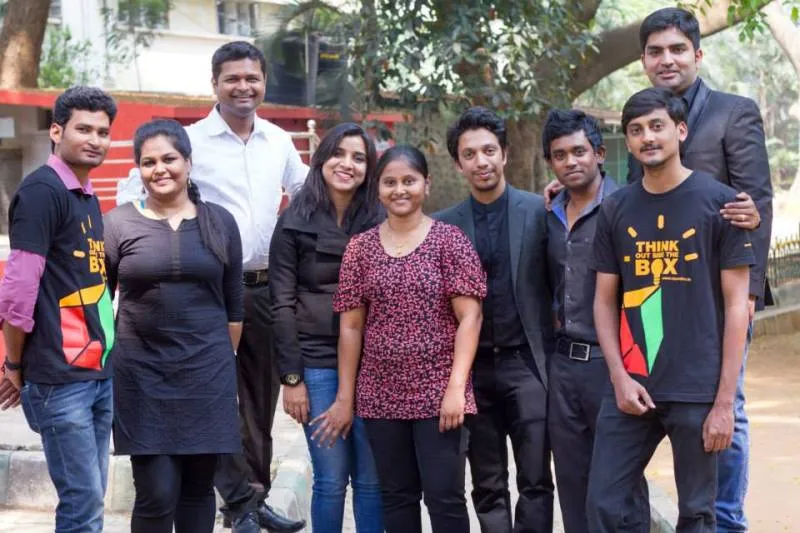Three entrepreneur friends hustle to launch Bonito Design and Squadro.in – the story of startup grit to chase a dream

April is special month for Sameer A M and Vathsala C R. Not only will their startup Squadro completes its third year this April, but will also have survived its first thousand days – an important milestone for any startup. This is a story about how Bonito Design was co-founded by three young entrepreneurs, and how that led to their new bootstrapped venture called Squadro.
In 2014, India’s home decor industry had a market size of $18 B, and in 2015, it is expected to grow to $20B. That is the opportunity these hungry entrepreneurs are gunning for. So far, they’ve completed 300 projects in Bangalore.

The genesis
Sameer and Vathsala were college buddies who went their separate ways. Vathsala, a designer, started working for HomeTown. Sameer worked for a tech company, and then moved to Motorola as an app developer. But Vathsala wasn’t creatively satisfied at the MNC, so she started freelancing. Meanwhile, Sameer grew fond of Internet marketing, and began toying with the idea of online advertising, search engine optimization, and blogging.
Vathsala’s designs were good, and people wanted more of them. Sameer thought of trying out her skills for his friend. He started advertising her work under a banner called Bonito Designs (bonito means beautiful). By early 2012, the duo had splashed a website and was advertising it everywhere.
Vathsala discovered in her association with multinationals that the clients were not satisfied with the purchase process. She tells YourStory, “If the client wanted to buy a single furniture, the contacts they had to go through a lengthy process. After the sale, if the client wanted to go back and talk about his product, he had to speak to a person who was not even aware of him to begin with.”
Vathsala adds, “For a customer who walks in to HomeTown s/he should be aware of his/her room dimensions. He/she should know ‘what comes where’ then take the furniture and place them. People were not even aware that there is a department called ‘design department’. There was no proper procedure to ask the client what they needed.”
That is when she discovered where the problem lay. But none of her managers heeded to her suggestions nor did they cooperate because the system was too big. If she as an employee of Home Town raised a concern it had to go all the way to the Mumbai HQ.
Vathsala would rave and rant over coffee to Sameer about unhappy customers. She would tell him how even though a customer was ready to pay there was no system in place to accommodate his customization needs. That’s when Sameer started to do his research. He tells YourStory, “Almost every other interior design service provider has this problem. It is not attributed to the company but the industry itself. It comes down to labor level management at the ground level, which the companies can’t control. A carpenter, a person who unloads stuff, the person who drills and fixes stuff – you can't bank on them. Tomorrow a carpenter or a laborer may switch off his phone. The company is the one who faces the heat from the customers,” says Sameer.
In most interior design companies there is no one point of contact for the client. This realization pushed them to exploit the opportunity to its full potential. Imagine you are buying a car; till the end of the sale, you’ll be contacting one sales person. But in interiors it is not like that though you spend the same amount of money.
Initial customer acquisition
For any startup acquiring its first client is a moment of magic. Sameer recalls the cold-calling days. He says, “We had a contact in one of the apartments who was working in a marketing position. He was kind enough to provide us with the list of his clients. During lunch and tea hours, we used to call them and ask ‘Are you looking for some sort of interior service?’ It was a very bad way of marketing to begin with. But for the first few clients we had to do it. What I was trying to do was trying to get them to visit the website. That was my intention. They saw the website and the message came through. They liked what they saw and called back.”
Vathsala had done a couple of design gigs for her friends while at Home Town. Even if she didn’t get paid for it handsomely then, it came in handy to showcase on the website, and win the hearts of their first two clients.
The beginning of a bumpy ride
For these two customers, they put in lots of effort and made sure everything came out well. But it gave them a reality check where negotiating prices were involved. “Financially speaking, the first two projects were loses because Vathsala is a designer and I am a software engineer, and we are not used to haggling with people,” says Sameer.
When Vathsala got paid in advance for the design she was really happy, and they got a good rapport going with the customer. But as soon as the design came in to execution stage, problems surfaced. Sameer says, “The problem came when we transitioned to execution of the design. We had to hire a vendor. We didn’t have any contact and it was pure experimentation.”
The friends hired vendors and carpenters, and the project rolled. “So we were sitting in between the customer and a vendor. A customer would go onsite and ask for changes and that caused friction between the vendor and us. What we promised to the customer, the vendor was not supplying it because he felt it cut into his profits. We stared to have fights with the vendor because we wanted to safeguard the customers’ interest,” says Sameer.
Sameer and Vathsala were not onsite all the time as they had a day job at that time. When a conversation happened between the vendor and the customer, the vendor would bad mouth them – saying ‘they took a lot of money from you. I’m only charging this much’. This started to chip off the customer’s trust. Things got so bad that the vendor stopped working on two different sites. For a customer all that mattered was why his work had stopped.
Sameer explains how they had to face the heat all the way. “The vendor ended up lodging a police complaint against us, saying we had not paid him his amount. And the customer did not pay us because the work had stopped. All in all we faced a loss of Rs 3 lakhs. But we came out clean and paid off the vendor.”
Vathsala had paid the vendor close to Rs. 8 lakh through online transactions. And the vendor claimed to have received only Rs 4 lakh. Vathsala says, “We took the slip to the police station and got it over with. These are the kind of people that the client has to deal with on a daily basis. We shield the customer from going through this, and charge them an extra 10 per cent – it’s worth it.”
The learning from the fiasco
From this incident, the young entrepreneurs learnt the mistake of outsourcing core processes. By April 2012, they had completed three projects and wanted to incorporate the company. Vathsala quit her job, as only she knew the technical aspect of the job. Sameer and Rickson, their third co-founder, who joined later, pooled to provide her with a salary to take care of her basic expenses for the following three months. They never had the funds to hire an employee till October that year.
Meeting invisible ecosystem enablers
They happen to find a place at dirt cheap price -- 1500 sft for Rs 15,000 per month. All their money was going there in building the factory. Between them they had about Rs. 3 lakh, and they paid Rs. 2 lakh as an advance. They leveraged the place to get orders. Sameer started to play with adwords, and they started getting calls. Though it required them lots of convincing in order to close those initial leads.
For the machines they were getting quotes of Rs. 35 lakh to 40 Lakh, as and they didn’t want to go to the Chinese model. In this process, they found a Bangalore-based vendor named Sandeep, who had the machinery they wanted. But they did not have the money to purchase and pleaded their case with him.
They literally begged him saying, ‘we are a startup; banks are not ready to give us loan’ and so on. I guess the universe was conspiring to make their dreams come true. Magically he agreed to give them the machines over a one year installment period. Behind most startups there are unsung hero-souls like Sandeep who throw a life-line with their kindness. These people are the invisible ecosystem enablers– without even asking to be included on the startups AngelList profile.
Fastening the entrepreneurial seat belt for a long ride
They didn’t have an income coming in, friend weren’t confident enough to support them. Parent were cut up that they quit their jobs. All doors were closed. The only way ahead was to rough it out and hustle.
Vathsala’s parents were unhappy as she had let go an MNC job. Sameer’s parents were telling him that from a computer science graduate, he wanted to become a carpenter. After he quit his job at Motorola, Google acquired it. His parents used to tell him – ‘you’d have become a Google employee but you walked out of the job’. (If he had stayed on he’d have become a Lenovo employee since Google sold Motorola!)
Recalls Sameer, “An early client named Nishant saw our website, called us, saw our faces, and trusted us. We didn’t even have an office to show him. Every time he asked to meet us in our office we evaded the questions. But he gave us money. We used it for paying advances to carpenters and so on. We completed his work successfully.” That money kickstarted their business.
They struggled for a year-and-half before they felt like they were running a company. They were doing everything from menial jobs to designing. Sometime there were no laborers, and the delivery truck would arrive. Even if there was a client discussion in progress, they stepped out and off-loaded, and resumed their discussion.
Since they didn’t have a separate office for customers, when a client come to the factory they had to switch off the machines to talk. Nor was there a proper toilet onsite. The team confessed that they have sent clients to the Pizzahut and CoffeeDay restrooms nearby. They all recall that time as a hard year of blood and sweat, and team bonding.
They know making a customer happy is synonymous to their existence. For a customer even if one percent of work is not done well, they’ll withhold 20-30% of the money. That means 100% of profit margin is being held hostage. Trust plays a huge factors in this; people usually don’t mind much when they pay to big brands. They just need to be convinced about the product. But with the startups it is different. People are skeptical by default as they are taking a bet on product and quality.
Customer satisfaction was crucial for them to get payments. And since they were not a brand, that was a hindrance.“Initially, customers were not ready to pull out money and we had expenses pilling up. Every other vendor was new to us and was unwilling to give us credit. If I had a project of Rs. 4 lakh, the customer would pay Rs 1.5-2 lakh as advance. But we would to pay the vendor the full cost of Rs. 3 lakh.” It took them a year to be on friendly terms with vendors.
Sameer recalls: “When 25th of the month would arrive, we would sweat, because we knew that salaries had to be paid and rent was coming up. Only in 2013 March, did we start to breathe. It is then we expanded to a bigger facility. As of now we stand at 12,000 sft space at Sahakaranagar in Bangalore. ”
By 2014, they had upgraded their machinery to a level that according to Sameer is “the cream of quality that you can provide to a customer.”
Sameer feels that if they have an xyz colored item, and not offering it to the customer that is their problem, not the customers. “What if the supply of this item is blocked later? It’s not being supplied to me, still the customer gets upset. There are small things that contribute to a customer’s dissatisfaction. That is when we came up with the idea of Squadro. To control customer satisfaction,” explains Sameer.

What is Squadro?
Squadro is a way to limit customization and the number of colors they offer. With Bonito they opened up entire catalogs to the client, that were being supplied by a third party. If an item goes out of stock Bonito does not have control over that market dynamics. It may look to the customer that they can’t supply as they are small players. But with Squadro, they keep their own stock and can satisfy customers from their catalog.
They have been working on the Squadro idea for over a year. It took this long because it was a bootstrapped effort. In March 2014, when Bonito’s revenue became strong they were able to hire a dedicated team for Squadro. At present, collectively they have a team of 70 in Bonito and Squadro, out of which 50 work for the former. As a culture they have given their employees a space to play where people can come up with their own designs and ideas. That has strengthened them.
“With Squadro, we want to take modular furniture nationwide; to take our brand across India. In fact, one of our secret negotiation technique is to tell employees when we expand to x city is you’ll be heading operations there. When an employee comes and says that he wants an x amount of salary, we say: we’ll give it to you;you want to work in Bangalore city or Hyderabad? We share our dreams with them. Only those who get the vision will stick with us because they relate to the dream,”says Sameer.
He adds, “At any point in time we had to earn and struggle for every penny. No one has given us anything for free. Along the way we made friends and memories. We have learnt a lot, not only in terms of technical and business aspects but at a character building level too”. Vathsala adds, “How we treat others. How we treat our employees.” We understood the importance of every little detail.”
Standing on ground during parental pressure
Sameer quips that because they are doing the opposite of what society expects them to, probably it will take them longer to get accepted. Vathsala shares what her parents tell her: “At least you are earning better now. Please stop now and settle down. Why do you want to work so hard?” But now it’s not only about money for them. Even stripped bare of the money, the experience holds value for them. “Sitting with our employees sharing a joke, drinking a cup of tea is more fun than going for a drive alone. It’s difficult to explain this to our parents because of the generation gap. It is like we are living in a parallel universe from our parents,”says Vatshala.
Visit their sites: http://bonito.in/ and http://squadro.in/











